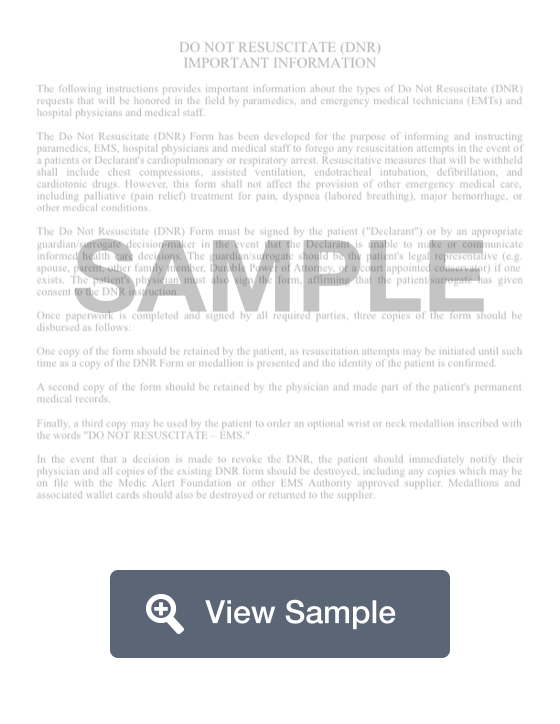What is a DNR form (Do Not Resuscitate)?
A Do Not Resuscitate order (DNR) is a medically related document that instructs medical personnel to cease performing life-sustaining treatment such as cardiopulmonary resuscitation (CPR), endotracheal intubation, and defibrillation. Most patients who initiate a DNR are terminally ill. People may also use them if they want to stay off life-support in the event of a coma or other serious injury or illness.
A Do Not Resuscitate form will be different for each state, although they all include similar information. A copy of the completed and signed form should be kept in the patient’s file at their physician’s office and hospitals. People who have a standing DNR order should also consider wearing a medical bracelet or necklace that indicates they have a Do Not Resuscitate standing.
Terminology
In the United States, Canada, United Kingdom, and New Zealand, “Do Not Resuscitate” and DNR are the most commonly used terms. Other similar terms that are used in some regions include:
- DNI - Do Not Intubate
- No Code
- DNAR - Do Not Attempt Resuscitation
- NFR - Not For Resuscitation
- NTBR - Not to Be Resuscitated
- Not for 222 (UK only, where 222 is used as the phone number for the emergency resuscitation team)
Who should have a DNR order form?
Anyone who feels strongly about not being resuscitated or intubated once their breathing and heart stops should consider having a form.
People with terminal illnesses or who are at high risk for stroke, cardiac arrest, or respiratory arrest often consider getting a DNR.
How do I get a DNR form?
Each state has different legal requirements about what must be included in a DNR. Verify your state’s laws to make sure that your DNR complies with all requirements.
Do Not Resuscitate orders are usually one-page documents that are fairly simple to prepare and execute. They can be included as part of advance directives or advanced healthcare directives. A DNR can also be included in a living will.
You can create a DNR online with a template or seek legal counsel to draft one for you.
How do DNR forms work?
How can I ensure an EMT will honor my DNR wish?
The best way to ensure that emergency medical services will honor your DNR wish is to make sure that the DNR is visible near the patient.
Will an EMT withhold resuscitative measures at the family request if the EMT can’t find my DNR?
No, EMS providers cannot withhold resuscitative measures unless they are absolutely certain that a qualified DNR order exists.
Can I reverse DNR orders?
Yes, you can reverse your decision at any time by destroying the document and its copies. You should contact your health care provider and family to notify them when you do so.
Are other legal documents acceptable in place of a DNR?
Legal documents such as Durable Power of Attorney for Health Care (DPAHC), advance directives, and living wills are valid documents that can take the place of a DNR in most circumstances. However, it is important to note that EMS personnel do not have the legal training or time that is required to read and interpret these documents. If they have doubts over the meaning or validity of those documents, they will likely provide resuscitative measures. It is advisable to also have a DNR, which is widely recognized by most EMTs and paramedics, to avoid any confusion.
State Guidelines
Can a state DNR form be used in a nursing facility or hospice?
Yes, a state DNR should be provided to the care facility and a copy should be clearly posted or maintained by the patient.
Is a California DNR approved in other states?
Each state has its own DNR laws. If you are traveling out of state, you should check that state’s public health department to determine what you will need to do to ensure that your DNR wishes will be followed.

